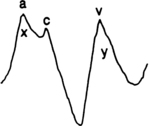PROCEDURE 71 The left atrial catheter measures pressure from the left atrium for assessment of left ventricular function after cardiac surgery in the setting of severe left ventricular dysfunction, pulmonary hypertension, presence of circulatory assist devices, or cardiac transplantation.2 The left atrial catheter provides information about left-sided intracardiac pressure. Hemodynamic information obtained with the left atrial catheter is used to guide therapeutic interventions, including administration of fluids and medications and titration of vasoactive and inotropic medications. • Knowledge of the cardiovascular anatomy and physiology is necessary. • Understanding of basic dysrhythmia recognition and treatment of life-threatening dysrhythmias is needed. • Advanced cardiac life support knowledge and skills are necessary. • Understanding is needed of the setup of the hemodynamic monitoring system (see Procedure 76). • Understanding of hemodynamic monitoring is necessary (see Procedure 73). • Principles of aseptic technique should be understood. • The left atrial pressure (LAP) waveform is configured similarly to that of a pulmonary artery occlusion pressure or pulmonary artery wedge pressure waveform (Fig. 71-1). • Understanding of a, c, and v waves is necessary. The a wave reflects left atrial contraction. The c wave reflects closure of the mitral valve. The v wave reflects passive filling of the left atrium during left ventricular systole. • The LAP is measured with a polyvinyl catheter placed in the left atrium during cardiac surgery. The left atrial catheter can be inserted via a needle puncture of the right superior pulmonary vein, with subsequent threading into the left atrium, or it can be inserted via direct cannulation of the left atrium through a needle puncture at the intraatrial groove.20 • LAP monitoring may be used in the following situations: • The normal LAP is 4 to 12 mm Hg. • One danger with use of this catheter is the potential for air or a blood clot embolus to enter the left atrium and be carried to the brain or other body organs. Close attention to the hemodynamic monitoring system and assessment of the waveform are imperative. • Left atrial catheter (inserted in the operating room) • Hemodynamic monitoring system (see Procedure 76). Additional equipment to have available, if needed, includes the following:
Left Atrial Catheter: Care and Assisting with Removal
PREREQUISITE NURSING KNOWLEDGE
 For patients with prosthetic tricuspid or pulmonic valves, in whom pulmonary artery catheters are contraindicated
For patients with prosthetic tricuspid or pulmonic valves, in whom pulmonary artery catheters are contraindicated
 For patients with abnormal heart anatomy (e.g., those with a single ventricle or tricuspid atresia)
For patients with abnormal heart anatomy (e.g., those with a single ventricle or tricuspid atresia)
 For patients with high pulmonary artery pressures, which may interfere with the correlation of pulmonary artery diastolic pressure (PADP) with pulmonary artery occlusion pressure (PAOP)
For patients with high pulmonary artery pressures, which may interfere with the correlation of pulmonary artery diastolic pressure (PADP) with pulmonary artery occlusion pressure (PAOP)
 For accurate information when vasoconstriction medications are infused in conjunction with pulmonary vasodilator medications
For accurate information when vasoconstriction medications are infused in conjunction with pulmonary vasodilator medications
EQUIPMENT
Anesthesia Key
Fastest Anesthesia & Intensive Care & Emergency Medicine Insight Engine





